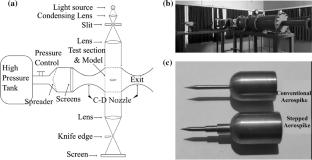Stepped aerospike for enhanced drag reduction using multiple intermediate shocks
Abstract
Drag reduction using aerospikes has been explored extensively due to the consequences associated with the range, manoeuvrability, and structural limitations of supersonic vehicles. The objective of the present work is to introduce steps as a novel aft-geometry configuration for a sharp-tipped aerospike to enhance drag reduction. The conventional and stepped spikes are of aspect ratio 1.5. Axisymmetric viscous flow simulations and wind-tunnel tests are conducted at a Mach number of 2.43 to analyze the drag reduction phenomena. The viscous simulations provide insight into the shock structure and the recirculation zones. Schlieren images obtained from the experiments in the wind tunnel reveal that the shock angles and locations are in reasonable agreement with the viscous flow simulations. The stepped geometry introduces multiple shocks which eventually reduce the strength of the reattachment shock. A detailed comparison of the location of the steps reveals the effect of the recirculation zones and the interaction of oblique shocks and expansion fans on the extent of drag reduction. The simulations indicate that an enhanced reduction in the wave drag ranging from 9.3 to 21.1% may be achieved over a conventional aerospike as the step locations are varied. The maximum drag reduction potential offered by the steps may be realized in practice using an actively adapting telescopic aerospike.


 求助内容:
求助内容: 应助结果提醒方式:
应助结果提醒方式:


